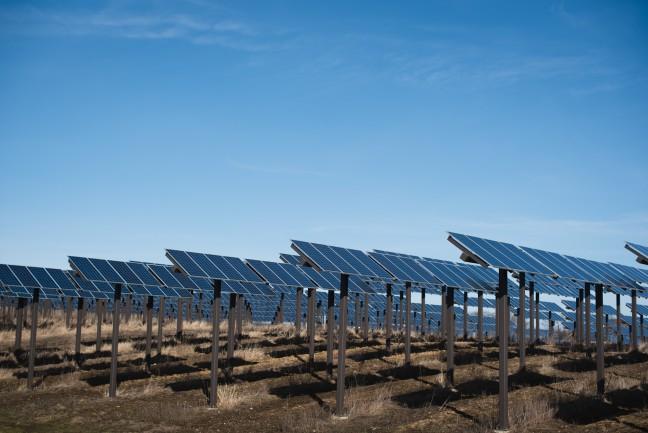As technology continues to advance, Wisconsin power companies are continuing to increase their reliance on renewable energy sources for power.
Some power companies have goals to significantly increase renewable energy usage by 2030, primarily through advances in wind and solar energy. This follows a trend of continued efforts by major power companies including Xcel Energy, Madison Gas and Electric, Dairyland Power, Alliant Energy and We Energies to make energy production cleaner.
Past advancements in renewable energy
In 2014, Xcel Energy led the state in green energy among big utility companies, with 19.5 percent of their electricity coming from renewable sources, according to a report by the Public Service Commision of Wisconsin. Dairyland Power Cooperative came in second with 12.8 percent of their power coming from renewable sources.
Alliant Energy had 11.5 percent of their electricity coming from renewables, and MGE had 10.6 percent renewables, according to the 2014 report. For We Energies, 7.9 percent of their electricity came from various renewable energy sources in Wisconsin.
Wind energy, solar energy, biomass and hydropower are all considered renewable energy sources because they never run out and have minimal environmental impact, Tyler Huebner, Renew Wisconsin executive director, said.
Though most power companies were only around the 10 percent mark for their reliance on renewables in 2014, some power companies have plans to significantly expand renewables in the future.
New goals for renewables
MGE has pledged to have renewables account for 30 percent of their electric sales by 2030, following a trend of increased efforts to use cleaner energy, Dana Brueck, MGE spokesperson, said in an email to The Badger Herald.
Brueck said this will follow MGE’s trend of reducing their carbon emissions by 20 percent since 2005 and discontinuing coal burning at their downtown Madison power plant.
Chris Ouellette, Xcel Energy spokesperson, said Xcel Energy has a similar goal of having renewables reach 35 percent of their power by 2030.
In addition, Alliant Energy plans on investing $3 billion from 2015-23 into projects that reduce their environmental impact.
To make these advancements in renewable energy, Ouellette said she expects to see the most growth in solar and wind power.
Here comes the sun: Solar power continues to advance
Ouellette said as technology advances, renewable energy sources become less expensive to produce and more popular. She said this is best seen with increasing developments in solar power.
“[The solar industry] is growing leaps and bounds because of utilities like us that are working with companies to contract solar power,” Ouellette said. “It’s just growing so quickly that there is just a lot of job opportunities available for people.”
Xcel Energy plans to add solar to their mix of power by 2017, Ouellette said.
Deb Mirasola, Dairyland Power spokesperson, said Dairyland Power announced this year that they are going to add 15 megawatts of solar, which is enough power to provide for 2,500 homes. Mirasola said Dairyland is also going to install solar panels in some schools to provide schools with more energy and teach kids about solar power.
Alliant Energy also has plans to make advancements in solar, as they announced a solar demonstration project at their Madison location in August 2015.
Huebner said as of February 2016, solar energy employed more than 1,900 people in Wisconsin and Dane County was one of three counties for the highest number of solar jobs. He also noted that demands for solar jobs keep going up.
Fun in the sun: Alliant Energy to study solar panel viability in Wisconsin
Wind energy gusts in from other states
Since 2008, We Energies has added nearly 200 wind turbines throughout Wisconsin, adding nearly 340 MW of electricity, according to We Energies’ website. 340 MW is enough power to provide for nearly 50,000 averaged sized homes for one year.
Ouellette said Xcel plans on making major wind installations in upcoming years, and not just in Wisconsin. She said since most of Wisconsin is not very flat, it doesn’t make sense to build wind turbines here, so Xcel instead plans to build more wind farms in Minnesota and North Dakota.
But the power generated by wind farms in other states will still get put into a power grid, which is also used by Wisconsin, Ouellette said.
Mirasola said Dairyland also plans on expanding wind, but mostly in Minnesota and Iowa. Wisconsinites, however, will also be able to use the power generated by these turbines, Mirasola said.
Despite national growth, wind power production stagnant in Wisconsin
Balancing power needs
Despite power companies’ continued efforts to rely on more environmentally friendly power sources, it is always a balance between meeting power needs and going green, Mirasola said.
Mirasola said it’s important to be able to serve customers’ electricity needs reliably, and renewable energy sources don’t always allow for that, since there’s no way to store power, it’s not always windy and the sun doesn’t shine at night.
Even so, renewable energy resources are an important part of providing economical and sustainable power, Mirasola said.
“It will continue to take a mix of base load and other generation to meet our needs for the future, but I do see an increase in renewable resources as part of that,” Mirasola said.













